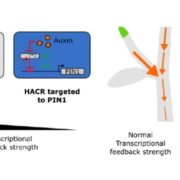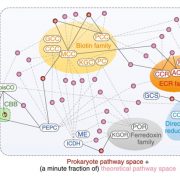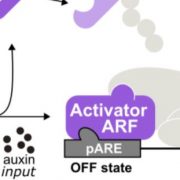Interviews with Synthetic Biologists: Cathie Martin
Synthetic biology is a set of tools, a way of thinking, the integration of engineering principles into biological sciences, and potentially the biggest opportunity for advances in plant sciences since PCR. Yet many struggle to define it, and fewer still grasp its full potential.
We have conducted a set of video interviews with leaders in the field of plant synthetic biology, in both academic and industrial arenas.
In the ningth of this series Interviews with Synthetic Biologists, Jaya Joshi, Postdoctoral Researcher with Andrew Hanson at the University of Florida, interviews Cathie Martin, Professor at the John Innes Centre (UK).
Among other projects, Cathie is interested in enhancing the nutritional quality of foods through metabolic engineering. She famously developed high-anthocyanin purple tomatoes. Jaya chatted with her about her thoughts on how to bring an idea from the lab to the table, public perceptions of synthetic biology, and how to succeed in a career in synthetic biology or metabolic engineering. The transcript of the interview is below.
Jaya Joshi interviews Cathie Martin from Plantae on Vimeo.
JJ. Hello everyone, my name is Jaya Joshi and I am a postdoctoral fellow in Dr. Andrew Hanson’s lab at the University of Florida. Thank you all for joining us in an exploration of plant synthetic biology. This is one of a series of interviews where we are talking to researchers from academia and industry in the run up to the first ASPB satellite meeting on Synthetic Biology, which is being held on 7 to 9 August in San Jose, California.
Joining me today is Dr. Cathie Martin, Project Leader at John Innes Centre at Norwich and Fellow of the Royal Society. Very warm welcome to you Dr. Martin.
My first question is very much basic, because we have known you for purple tomatoes and blood oranges. So I would like for you to tell us more about your research focus and recent developments.
CM. I’m very interested in trying to engineer metabolism, and I’m particularly interested in modifying metabolism so that more nutritious compounds are made in the parts that we eat. So a lot of my research is based on understanding how to do that engineering and also how to test whether the fruits of our labor (if you like) are actually nutritionally improved or not.
JJ. You’re not only a leading scientist in the academic world, but you are also working on your industry adventure. Could you tell us about that?
CM. Well, actually we have a couple of spin-out companies. I’ve got Norfolk Plant Sciences, or NPS, and also have a small company called Persephone Bio. These are for different aspects of the work that we’re doing. They’re basically spin-out companies which are set up simply to try to transduce what we do in research to practice. That is, to try to produce useful products that can come out of fundamental research.
For that type of exercise, especially in synthetic biology or plant metabolic engineering, which is what I do, I think that you really need a spin-out as a vehicle to do it. No one is going to take a nutritionally enhanced tomato and patent it and then sell it very easily. The patent and license model doesn’t really work for academics at all because it takes too long for you to get a return.
So Norfolk Plant Sciences was set up more than ten years ago and there we’re trying to produce a purple tomato juice that we’ll sell to people because it has proven health benefits associated with the high anthocyanins in the fruit.
With Persephone Bio we’re very interested in putting ingredients into cosmetics. There the problems are not so great in that people don’t have a worry or concern about the product being genetically modified as long as they work. And we’re interested in making cosmetics that do protect skin in particular from aging and particularly from photodamage.
So it’s two different applications with two different companies. But with the same thing, that we can take our time to get products, we’re not under constant pressure from having gone public and having to fulfill deadlines. We’re very fundamentally based.
JJ. To follow that question, how challenging is it to take your research from lab then to field and then actually to the table. How challenging is it?
CM. [Laughs] It’s incredibly challenging and I would say that in terms of application it’s a completely different world. The criteria that you need to establish something scientifically are completely different from the criteria that you need to think about in terms of getting a product. There’s an enormous amount of regulatory approval that you have to go through and preparation of dossiers to prove safety, and in addition we want to do things that actually work, so we have efficacy as well to consider.
And many of the very good ideas just don’t fly economically, because you have a yield penalty or something like that. So you have to take all of these factors into consideration. A lot of people think that if you switch over to applications then you lose interest or don’t have time to do fundamental research. I would say that on the plus side is that trying to work on applications often raises new fundamental questions, and thinking about how to get around problems that arise. So there is a lot of fundamental research that you only really identify as being necessary to address once you start to try to apply something.
JJ. So you are a metabolic engineer and a pioneer in synthetic biology. What is the overlap between these two?
CM. I would say that metabolic engineering is a subset of synthetic biology. With synthetic biology, when it first was adopted, a lot of people who were addressing other questions like developmental questions also claimed to be doing synthetic biology. I don’t see so much success there. I think it is more to do with metabolic engineering, or maybe that’s just the world I live in.
I think also it’s important that I work on plants, and my interests are in metabolic engineering in plants. I’m not very interested in doing things in microorganisms. I work on Chinese medicinal plants. We could be working on trying to produce those in microbes, but I leave that to other people.
I think there’s quite a big difference between synthetic biology in microbes and synthetic biology in plants. Not in terms of the objective, the objective is always productivity, yield, and ability to get pure compounds out in the end. If you’re thinking about food, you have to do it in plants, I believe. Also I think the tools and the way you think about the engineering is completely different in a eukaryote compared to a prokaryote and there’s different rules that apply.
JJ. This is a question that’s maybe related to Europe, because I am in the US, that Europe has a very strict regulation for GMOs. We have seen I would say a slow and steady acceptance of this technology. So how is synthetic biology making its path in Europe?
CM. I don’t see any difference between synthetic biology and GMOs. All synthetic biology involves genetic modification. I think genome editing is wonderful, we’re doing a lot of it now, it’s very easy in tomato. But it’s not the complete answer, at least with the technology available at the moment. If you want to add a new trait you can’t do it with genome editing, or it’s very, very hard to do it. It’s easy to take something away, but not to add something new. I think synthetic biology into the future is going to need to embrace genetic modification still, and somehow work towards making it acceptable.
The purple tomatoes are just one example of something that’s actually better for you. A lot of people who are against GMOs say, “You know, the dangers, the risk,” and we’ve actually made something that’s better for people to eat, and I have the regulatory dossier from the FDA that says that they are safe. So I think if we can start to persuade people that you can do good things with it, that have benefits for society, then we can break the barrier against genetic engineering generally.
I do believe always that there should be an element of choice so that you shouldn’t force something on somebody if they don’t want to eat it. Like a lot of things, like the potato originally, if you let people chose to eat them then they don’t worry about them being poisonous.
JJ. So what are your thoughts on the future of synthetic biology and do you think we are exploring its full potential?
CM. I’m not sure. My former colleague Giles Oldroyd called his project on introducing nitrogen fixation into cereals synthetic biology, and I think it is. It’s not come to fruition yet.
I suppose for a lot of traits that I’m interested in I want to use the most expedient route to get to something. So, purple tomatoes, you do it by GMO because there isn’t natural variation available. We’re also working on projects that could be classified as synthetic biology, for example removing toxins from plants, and there, if you’re thinking about removing toxins from cassava or from the other plant I work on, grass pea, Lathyrus sativus, there, a mutagenesis approach is much preferable because there is no regulatory burden. If you use EMS (a mutagen) to make a mutant that doesn’t make the toxin, then you can apply it within a couple years. So it may not be as sophisticated as doing synthetic biology, but you get to where you want to be quickly.
That’s the basic thinking about it, if you have an objective, then you use the most expedient technology to get there. But sometimes it takes longer. But the future of synthetic biology in plants is to think of the best way to get where you want to be.
JJ. This is my last question but very important. You have mentored a large number of successful scientists in the area of metabolic engineering. What is your advice for young enthusiastic scientists like me who want to move as a metabolic engineer or in a career in synthetic biology.
CM. I would say start with a plant that’s relatively easy to work with, that have good genetic resources as well as being one you’re able to transform. If you’re thinking about accumulating particular metabolites in particular places, whether it’s a medicine or a nutrient, always do it specifically in the part of the plant that you eat. So don’t use the 35S promoter to do anything, because you’ll have a yield penalty. Always do it fruit specifically or seed specifically because that’s where you’ll be successful.
Choose a target that not everybody else is working on, but on that people say is worthwhile to do. Do some research about the particular target. With the L-DOPA, that came from talking to doctors who work in Africa, saying, “This is a real problem. If we could find a way to solve it, by producing the medicine in plants then it would help us locally.”
Think about the social context of the metabolic engineering or synthetic biology you’re going, think about what context its set in, and then you’ll be more successful.
JJ. Thank you so much for being here.
Jaya Joshi has a BSc in Agriculture from Pantnagar University and MSc in Plant biochemistry from University of Agriculture Sciences, Bangalore in her native India. She started her career working as a data mining scientist for Monsanto and later moved to Global marker technologies team of Pioneer-Dupont. She then moved to Canada for a PhD in Cell and Molecular Biology at the University of Western Ontario, studying sulfur amino acid metabolism in developing bean seeds. Since November 2017 Jaya has been a synthetic biology postdoc in the Hanson lab at University of Florida where she is working on metabolic parts-prospecting and on continuous directed evolution of thiamin synthesis enzymes. Follow Jaya on Twitter at @JayaJoshi20.
Previously in this series:
- Steven Burgess interviews Professor Jennifer Nemhauser, University of Washington.
- Steven Burgess interviews Michael Mendez, Renew Biopharma.
- Steven Burgess interviews Matthew Mattozzi, Conagen Inc.
- Jenna Gallegos interviews Tobias Erb, Max Planck Institute for Terrestrial Microbiology in Marburg
- Jenna Gallegos interviews Guillaume Barbier, Joyne Bio.
- Jeanna Gallegos interviews Karsten Temme
- Henrik Toft Simonsen interviews Paul South
- Mary Williams interviews Kevin Chen









